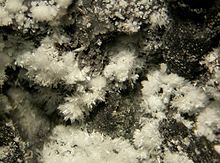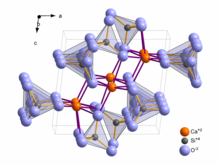Wollastonite
| Wollastonite | |
|---|---|
 | |
| General | |
| Category | Inosilicatemineral |
| Formula (repeating unit) | Calcium metasilicate, CaSiO3 |
| IMA symbol | Wo[1] |
| Strunz classification | 9.DG.05 |
| Crystal system | Triclinic Monoclinicpolytypeexists |
| Crystal class | Pinacoidal (1) (sameH-M symbol) |
| Space group | P1(Triclinic) P21/a(Monoclinic) |
| Unit cell | a = 7.925Å,b = 7.32 Å, c = 7.065 Å; α = 90.055°, β = 95.217°, γ = 103.42°; Z = 6 |
| Identification | |
| Formula mass | 116.159g/mol |
| Color | White, colorless or gray |
| Crystal habit | Rare as tabular crystals—commonly massive in lamellar, radiating, compact and fibrous aggregates. |
| Twinning | Common |
| Cleavage | Perfect in two directions at near 90° |
| Fracture | Splintery to uneven |
| Mohs scalehardness | 4.5 to 5.0 |
| Luster | Vitreous or dull to pearly on cleavage surfaces |
| Streak | White |
| Diaphaneity | Transparent to translucent |
| Specific gravity | 2.86–3.09 |
| Optical properties | Biaxial (−) |
| Refractive index | nα= 1.616–1.640 nβ= 1.628–1.650 nγ= 1.631–1.653 |
| Birefringence | δ = 0.015 max |
| 2V angle | Measured: 36° to 60° |
| Melting point | 1540 °C |
| Solubility | Soluble in HCl, insoluble in water |
| Other characteristics | Heat of formation (@298): −89.61kJ Gibbs free energy: 41.78kJ |
| References | [2][3][4][5][6] |
Wollastoniteis a calciuminosilicatemineral (CaSiO3) that may contain small amounts ofiron,magnesium,andmanganesesubstituting for calcium. It is usually white. It forms when impurelimestoneordolomiteis subjected to high temperature and pressure, which sometimes occurs in the presence of silica-bearing fluids as inskarns[7]or in contact withmetamorphic rocks.Associatedmineralsincludegarnets,vesuvianite,diopside,tremolite,epidote,plagioclasefeldspar,pyroxeneandcalcite.It is named after the English chemist and mineralogistWilliam Hyde Wollaston(1766–1828).
Despite its chemical similarity to the compositional spectrum of the pyroxene group of minerals—where magnesium (Mg) and iron (Fe) substitution for calcium ends withdiopsideandhedenbergiterespectively—it is structurally very different, with a thirdSiO4−4tetrahedron[8]in the linked chain (as opposed to two in the pyroxenes).
Production trends
[edit]
Estimated world production of crude wollastonite ore was 1,200,000tonnesin 2021. World reserves of wollastonite are estimated to exceed 100 million tonnes, though some existing deposits have not been surveyed.
Major producers of wollastonite include China, India, the United States, Mexico, and Finland.[9]
In the United States, wollastonite is mined inWillsboro, New York(the first laboratory for local wollastonite research was inEssex, New Yorkby Koert Burnham in the 1940s. The original laboratory building still exists as a residential & commercial building) andGouverneur, New York.Deposits have also been mined commercially in North WesternMexico.[10]
The price of raw wollastonite in 2008 varied between US$80 and US$500 per tonne depending on the country and size and shape of the powder particles.[10]
Uses
[edit]Wollastonite is among the fastest reacting silicates, but may have high costs associated with carbon storage.[11]Addition of wollastonite to soil stimulates organic carbon mineralization.[12]
Ceramics
[edit]Wollastonite has industrial importance in ceramics manufacturing as an additive.[13]
In ceramics, wollastonite decreases shrinkage and gas evolution duringfiring,increasesgreenand fired strength, maintains brightness during firing, permits fast firing, and reduces crazing, cracking, and glaze defects.[citation needed]
Construction
[edit]Wollastonite can serve as a substitute forasbestosin floor tiles, friction products,insulating boardand panels, paint,plastics,and roofing products. Similar to asbestos, wollastonite is resistant to chemical attack, stable at high temperatures, and improves flexural and tensile strength in composites.[10]In some industries, wollastonite is used in different percentages of impurities, such as its use as a fabricator of mineral wool insulation, or as an ornamental building material.[14] Wollastonite is used in a cement announced in 2019 which "reduces the overallcarbon footprintinprecast concreteby 70%. "[15]
Wollastonite has been studied for carbon mineralization for storage ofcarbon dioxide(CO2) according to the following reaction:[16]
Metallurgy
[edit]In metallurgical applications, wollastonite serves as a flux for welding, a source for calcium oxide, a slag conditioner, and to protect the surface of molten metal during the continuous casting of steel.[citation needed]
Paint
[edit]As an additive in paint, wollastonite improves the durability of the paint film, acts as apHbuffer, improves its resistance to weathering, reduces gloss, reduces pigment consumption, and acts as a flatting and suspending agent.[citation needed]
Plastic
[edit]In plastics, wollastonite improvestensileandflexural strength,reduces resin consumption, and improves thermal and dimensional stability at elevated temperatures. Surface treatments are used to improve the adhesion between the wollastonite and the polymers to which it is added.[citation needed]
Plastics and rubber applications were estimated to account for 25% to 35% of U.S. sales in 2009, followed by ceramics with 20% to 25%; paint, 10% to 15%; metallurgical applications, 10% to 15%; friction products, 10% to 15%; and miscellaneous, 10% to 15%. Ceramic applications probably account for 30% to 40% of wollastonite sales worldwide, followed by polymers (plastics and rubber) with 30% to 35% of sales, and paint with 10% to 15% of sales. The remaining sales were for construction, friction products, and metallurgical applications.[citation needed]
Substitutes
[edit]
Theacicularnature of many wollastonite products allows it to compete with other acicular materials, such as ceramic fiber, glass fiber, steel fiber, and several organic fibers, such asaramid,polyethylene,polypropylene,andpolytetrafluoroethylenein products where improvements in dimensional stability, flexural modulus, and heat deflection are sought.
Wollastonite also competes with several nonfibrous minerals or rocks, such askaolin,mica,andtalc,which are added to plastics to increase flexural strength, and such minerals as barite, calcium carbonate, gypsum, and talc, which impart dimensional stability to plastics.
In ceramics, wollastonite competes with carbonates,feldspar,lime,andsilicaas a source of calcium and silicon. Its use in ceramics depends on the formulation of the ceramic body and the firing method.[9]
Composition
[edit]In a pure CaSiO3,each component forms nearly half of the mineral by weight: 48.3% of CaO and 51.7% of SiO2.In some cases, small amounts of iron (Fe), and manganese (Mn), and lesser amounts of magnesium (Mg) substitute for calcium (Ca) in the mineral formula (e.g.,rhodonite).[14]Wollastonite can form a series of solid solutions in the system CaSiO3-FeSiO3,orhydrothermal synthesisof phases in the system MnSiO3-CaSiO3.[13]
Geologic occurrence
[edit]
Wollastonite usually occurs as a common constituent of a thermally metamorphosed impurelimestone,it also could occur when thesiliconis due tometamorphismin contact altered calcareous sediments, or to contamination in the invadingigneous rock.In most of these occurrences it is the result of the following reaction betweencalciteandsilicawith the loss ofcarbon dioxide:[13]
- CaCO3+ SiO2→ CaSiO3+ CO2
Wollastonite may also be produced in adiffusionreaction inskarn,it develops whenlimestonewithin asandstoneis metamorphosed by adike,which results in the formation of wollastonite in the sandstone as a result of outward migration of Ca.[13]
Structure
[edit]

Wollastonite crystallizestriclinicallyinspace groupP1with thelattice constantsa= 7.94Å,b= 7.32 Å, c = 7.07 Å;α= 90,03°,β= 95,37°,γ= 103,43° and sixformula unitsperunit cell.[17]Wollastonite was once classed structurally among the pyroxene group, because both of these groups have a ratio of Si:O = 1:3. In 1931, Warren and Biscoe showed that the crystal structure of wollastonite differs from minerals of the pyroxene group, and they classified this mineral within a group known as thepyroxenoids.[13]It has been shown that the pyroxenoid chains are more kinked than those of pyroxene group, and exhibit longer repeat distance. The structure of wollastonite contains infinite chains of [SiO4] tetrahedra sharing common vertices, running parallel to theb-axis. The chain motif in wollastonite repeats after three tetrahedra, whereas in pyroxenes only two are needed. The repeat distance in the wollastonite chains is 7.32 Å and equals the length of the crystallographicb-axis.
Molten CaSiO3maintains a tetrahedral SiO4local structure at temperatures up to 2000 °C.[18]The nearest neighbor Ca-O coordination decreases from 6.0(2) in the room temperature glass to 5.0(2) in the 1700 °C liquid, coincident with an increasing number of longer Ca-O neighbors.[19][20]
See also
[edit]- Enstatite– Pyroxene: magnesium-iron silicate with MgSiO3and FeSiO3end-members
- List of minerals
- List of minerals named after people
References
[edit]![]() This article incorporatespublic domain materialfromWollastonite.United States Geological Survey.
This article incorporatespublic domain materialfromWollastonite.United States Geological Survey.
- ^Warr, L.N. (2021)."IMA–CNMNC approved mineral symbols".Mineralogical Magazine.85(3): 291–320.Bibcode:2021MinM...85..291W.doi:10.1180/mgm.2021.43.S2CID235729616.
- ^Wollastonite,Mindat
- ^Wollastonite,Webmineral
- ^Wollastonite,Handbook of Mineralogy
- ^American Mineralogist, V. 79, pp. 134-144, 1994
- ^Virta, Robert; Van Gosen, Brad (January 27, 2015)."Mineral Resource of the Month: Wollastonite".Earth Magazine.American Geosciences Institute.
- ^Whitley, Sean; Halama, Ralf; Gertisser, Ralf; Preece, Katie; Deegan, Frances M.; Troll, Valentin R. (2020-10-18)."Magmatic and Metasomatic Effects of Magma–Carbonate Interaction Recorded in Calc-silicate Xenoliths from Merapi Volcano (Indonesia)".Journal of Petrology.61(4).doi:10.1093/petrology/egaa048.ISSN0022-3530.
- ^William Alexander Deer; Robert Andrew Howie; J. Zussman (1992).An introduction to the rock-forming minerals.Longman Scientific & Technical.ISBN978-0-470-21809-9.
- ^abWollastonite,Mineral Commodity Summaries2021
- ^abcRobert L. VirtaWollastonite,USGS 2009 Minerals Yearbook(October 2010)
- ^National Academies of Sciences, Engineering, and Medicine (2019). "Chapter 6, Carbon mineralization of CO2".Negative Emissions Technologies and Reliable Sequestration: A Research Agenda (Report). Washington, DC: The National Academies Press.doi:10.17226/25259.ISBN978-0-309-48452-7.
{{cite report}}:CS1 maint: multiple names: authors list (link) - ^Yan, Yongxue; Dong, Xiaohan; Li, Renshan; Zhang, Yankuan; Yan, Shaokui; Guan, Xin; Yang, Qingpeng; Chen, Longchi; Fang, Yunting; Zhang, Weidong; Wang, Silong (2023)."Wollastonite addition stimulates soil organic carbon mineralization: Evidences from 12 land-use types in subtropical China".Catena.225.Bibcode:2023Caten.22507031Y.doi:10.1016/j.catena.2023.107031.S2CID257202041.
- ^abcdeDeer, Howie and Zussman.Rock Forming Minerals; Single Chain Silicates,Vol. 2A, Second Edition, London, The Geological Society, 1997.
- ^abAndrews, R. W. (1970).Wollastonite.London, Her Majesty's Stationery Office.
- ^Alter, Lloyd (August 15, 2019)."LafargeHolcim is selling CO2-sucking cement for precast, reduces emissions by 70 percent ".TreeHugger.Retrieved2019-08-17.
- ^Haque F, Santos RM, Dutta A, Thimmanagari M, Chiang YW (January 2019)."Co-Benefits of Wollastonite Weathering in Agriculture: CO2 Sequestration and Promoted Plant Growth".ACS Omega.4(1): 1425–1433.doi:10.1021/acs Omega.8b02477.PMC6374988.PMID30775646.
- ^Buerger, M. J. (1961)."The crystal structures of wollastonite and pectolite".Proceedings of the National Academy of Sciences.47(12): 1884–1888.Bibcode:1961PNAS...47.1884B.doi:10.1073/pnas.47.12.1884.JSTOR71064.PMC223235.PMID16578516.
- ^Benmore, C.J.; et al. (2010)."Temperature-dependent structural heterogeneity in calcium silicate liquids".Phys. Rev. B.82(22): 224202.Bibcode:2010PhRvB..82v4202B.doi:10.1103/PhysRevB.82.224202.hdl:2160/8569.S2CID67808796.
- ^Skinner, L.B.; et al. (2012). "Structure of molten CaSiO3:Neutron diffraction isotope substitution with aerodynamic levitation and molecular dynamics Study ".J. Phys. Chem. B.116(45): 13439–13447.doi:10.1021/jp3066019.PMID23106223.
- ^Eckersley, M.C.; et al. (1988). "Structural ordering in a calcium silicate glass".Nature.355(6190): 525–527.Bibcode:1988Natur.335..525E.doi:10.1038/335525a0.S2CID4360261.
External links
[edit]- Oxford University MSDS sheetArchived2007-08-15 at theWayback Machine
